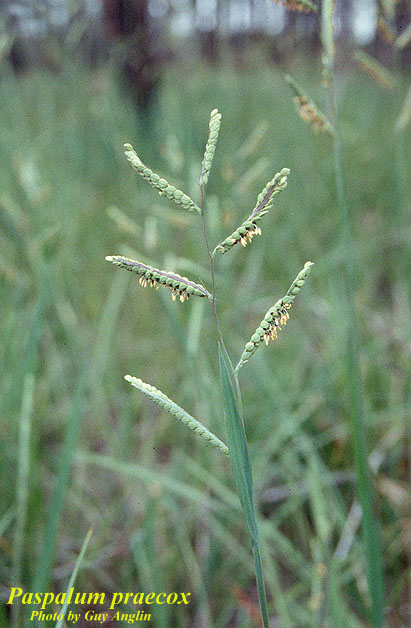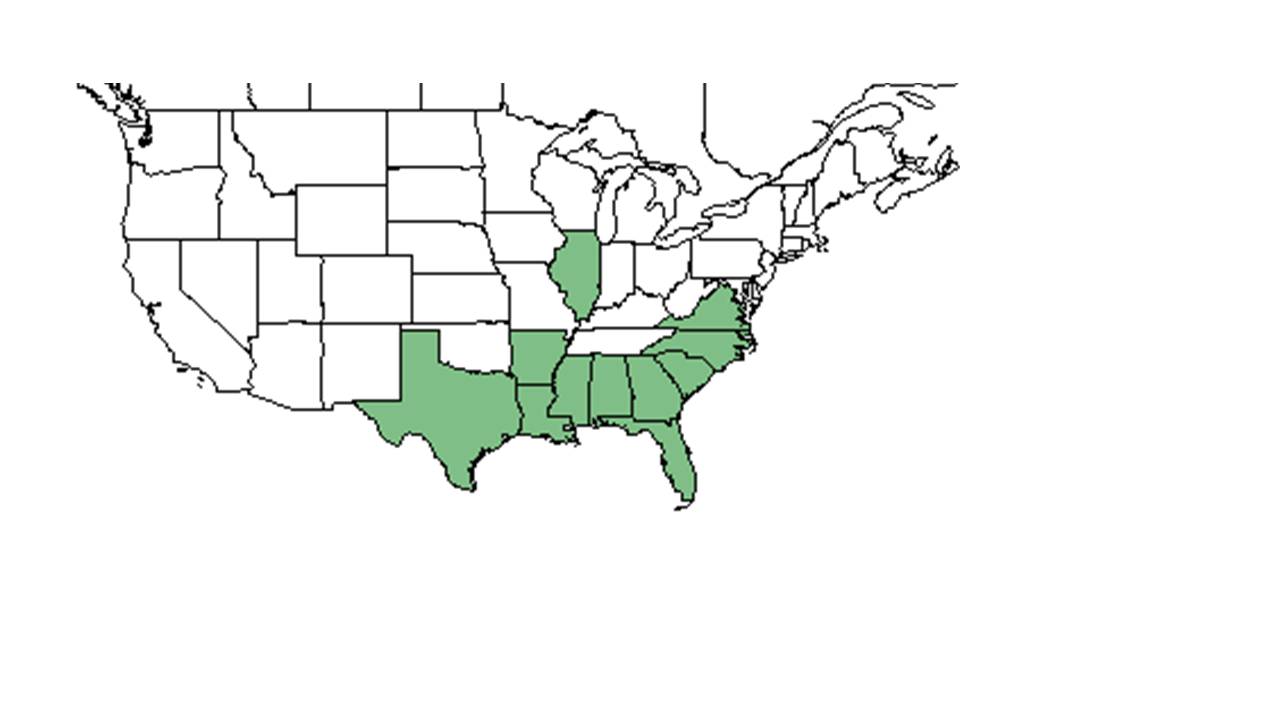Difference between revisions of "Paspalum praecox"
(→Taxonomic notes) |
(→Ecology) |
||
| Line 33: | Line 33: | ||
This species has been found growing in open areas of longleaf and slash pine in wet, sandy and peaty soils (FSU Herbarium). It has also been found in moist, loose, and loamy sands of ditches along trails within pine plantations (FSU Herbarium). Associated species include ''Andropogon, Sorghastrum,'' and ''Pinus palustris'' (FSU Herbarium). | This species has been found growing in open areas of longleaf and slash pine in wet, sandy and peaty soils (FSU Herbarium). It has also been found in moist, loose, and loamy sands of ditches along trails within pine plantations (FSU Herbarium). Associated species include ''Andropogon, Sorghastrum,'' and ''Pinus palustris'' (FSU Herbarium). | ||
| − | |||
===Phenology=== <!--Timing off flowering, fruiting, seed dispersal, and environmental triggers. Cite PanFlora website if appropriate: http://www.gilnelson.com/PanFlora/ --> | ===Phenology=== <!--Timing off flowering, fruiting, seed dispersal, and environmental triggers. Cite PanFlora website if appropriate: http://www.gilnelson.com/PanFlora/ --> | ||
This species has been observed flowering in July and fruiting in October (FSU Herbarium). | This species has been observed flowering in July and fruiting in October (FSU Herbarium). | ||
| − | + | <!--===Seed dispersal===--> | |
| − | ===Seed dispersal=== | + | <!--===Seed bank and germination===--> |
| − | ===Seed bank and germination=== | ||
===Fire ecology=== <!--Fire tolerance, fire dependence, adaptive fire responses--> | ===Fire ecology=== <!--Fire tolerance, fire dependence, adaptive fire responses--> | ||
This species can be found in burned, open longleaf pine areas (FSU Herbarium). | This species can be found in burned, open longleaf pine areas (FSU Herbarium). | ||
| + | <!--===Pollination===--> | ||
| + | <!--===Use by animals===--> <!--Herbivory, granivory, insect hosting, etc.--> | ||
| + | <!--===Diseases and parasites===--> | ||
| − | |||
| − | |||
| − | |||
==Conservation and Management== | ==Conservation and Management== | ||
==Cultivation and restoration== | ==Cultivation and restoration== | ||
Revision as of 15:40, 29 June 2016
| Paspalum praecox | |
|---|---|

| |
| Photo by Guy Anglin, Atlas of Florida Vascular Plants | |
| Scientific classification | |
| Kingdom: | Plantae |
| Division: | Magnoliophyta - Flowering plants |
| Class: | Liliopsida – Monocotyledons |
| Order: | Cyperales |
| Family: | Poaceae ⁄ Gramineae |
| Genus: | Paspalum |
| Species: | P. praecox |
| Binomial name | |
| Paspalum praecox Walter | |

| |
| Natural range of Paspalum praecox from USDA NRCS Plants Database. | |
Common name: Early paspalum
Contents
Taxonomic notes
Synonyms: Paspalum praecox Walter var. curtisianum (Steudel) Vasey; P. lentiferum Lamarck
Description
"Annuals or perennials. Leaves primarily basal and low cauline; blade margins usually scaberulous; ligules membranous. Spikelets plano-convex, terminal floret fertile, basal floret sterile. Frist glume usually absent, sterile lemma resembles 2nd glume; fertile lemma and paleas indurate, lustrous, yellowish or brownish. These plants are all important forage grasses." - Radford et al 1964
"Erect perennial from short rhizomes; culms 6-9 dm tall, nodes and internodes glabrous. Blades to 20 cm long, 1.5-4 mm wide, glabrous or villous on both surfaces, occasionally pilose basally above; sheaths glabrous, villous or sparsely papillose above, margins smooth; ligules 2-2.5 mm long. Racemes 3-5, racemose, ascending, 2-6 cm long; rachis wing scaberulous, 1-1.2 mm wide. Spikelets broadly obovoid to suborbicular, flattish, 2.2-3.2 mm long, in 4 rows, 2 rows rudimentary; pedicels scaberulous angled, 0.1-1 mm long. Second glume and sterile lemmas 3-nerved, yellowish green , margins scarious, obtuse 2.2-3.2 mm long; fertile lemma and palea nerveless, papillose, obtuse, 2.2-3.2 mm long. Grain brownish, broadly ellipsoid, flat, 2 mm long." - Radford et al 1964
Distribution
Ecology
Habitat
This species has been found growing in open areas of longleaf and slash pine in wet, sandy and peaty soils (FSU Herbarium). It has also been found in moist, loose, and loamy sands of ditches along trails within pine plantations (FSU Herbarium). Associated species include Andropogon, Sorghastrum, and Pinus palustris (FSU Herbarium).
Phenology
This species has been observed flowering in July and fruiting in October (FSU Herbarium).
Fire ecology
This species can be found in burned, open longleaf pine areas (FSU Herbarium).
Conservation and Management
Cultivation and restoration
Photo Gallery
References and notes
Florida State University Robert K. Godfrey Herbarium database. URL: http://herbarium.bio.fsu.edu. Last accessed: June 2014. Collectors: Loran C. Anderson, Wilson Baker, Ann F. Johnson, Robert K. Godfrey, R. Komarek, Travis MacClendon, and Karen MacClendon. States and Counties: Florida: Calhoun, Dixie, Liberty, and Wakulla. Georgia: Thomas.
Radford, Albert E., Harry E. Ahles, and C. Ritchie Bell. Manual of the Vascular Flora of the Carolinas. 1964, 1968. The University of North Carolina Press. 136. Print.